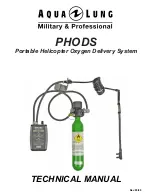
ATI
Q46H/65 Residual Chlorine Dioxide System
Part 10
– Troubleshooting
59
O&M Manual
Rev-J (11/18)
9.4
Sensor Acid Cleaning
Over an extended operating period, ClO
2
sensors can slowly accumulate deposits on the surface
of the platinum electrode. Typically, this type of buildup occurs over years of operation, but can
sometimes occur more quickly if high levels of manganese, iron, or other metals are dissolved in
the water. The platinum electrode can be “acid cleaned” using nitric acid solutions.
To acid clean the electrode assembly, remove the electrolyte chamber from the sensor so that
the so that both electrodes are exposed. Then follow the procedure below.
1. Place a small amount of 50% nitric acid solution in a beaker. Put in just enough so that the
platinum tip of the sensor can be submerged without any contact with the silver coil.
2. Allow the sensor to soak in this acid solution for 2 minutes. Remove the sensor body and
rinse the platinum tip thoroughly with distilled water. Discard the nitric acid safely and
according to all environmental regulations.
3. Fill the beaker with distilled water to the level sufficient to submerge both the tip and the silver
coil. Do not allow the connector at the back of the sensor to be submerged. Allow the
electrodes to soak in distilled water for 30 minutes.
4. Put a new membrane and fresh electrolyte in the electrolyte chamber and reassemble the
sensor. Connect to the ClO
2
monitor electronics and allow the sensor to stabilize for at least
24 hours. The sensor can be placed in the flow cell with chlorinated water running through it
during stabilization. However, the readings will not be useful for 24 hours.
9.5
Q22P Sensor Cleaning
Keep the sensor as clean as possible for optimum measurement accuracy - this includes both the
saltbridge and the measuring electrode glass. Frequency of cleaning depends upon the process
solution.
Carefully wipe the measuring end of the sensor with a clean soft cloth. Then rinse with clean,
warm water - use distilled or de-ionized water if possible. This should remove most contaminate
buildup.
Prepare a mild solution of soap and warm water. Use a non-abrasive detergent (such as
dishwashing liquid).
NOTE
:
DO NOT use a soap containing any oils (such as lanolin). Oils can coat the glass
electrode and harm sensor performance
.
WARNING
THIS ACID CLEANING PROCEDURE INVOLVES THE USE OF
HIGHLY CORROSIVE ACID SOLUTIONS. IT SHOULD ONLY BE
COMPLETED BY TRAINED PERSONNEL USING PROTECTIVE
EYEWEAR AND GLOVES. IF THERE IS ANY DOUBT ABOUT
YOUR ABILITY TO SAFELY ACCOMPLISH THIS PROCEDURE,
RETURN THE SENSOR TO ATI FOR FACTORY CLEANING!












































